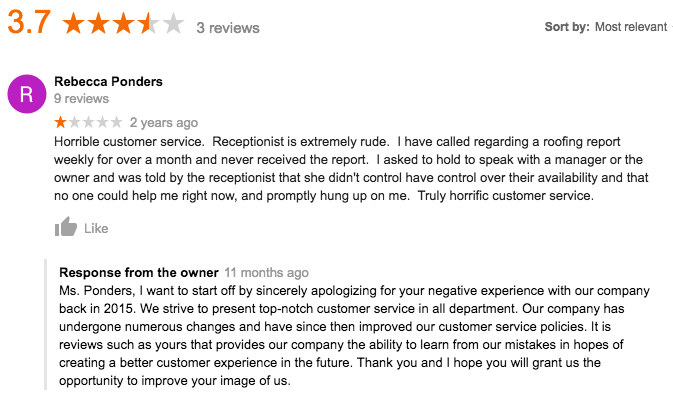
If you work in the hospitality industry, you're probably all too familiar with how damaging a bad Google Review or star-rating on Tripadvisor can be for business.
Customers look to reviews to gauge your restaurant or bar's authenticity as a brand and quality as a service. In fact, research shows that 91 percent of people regularly or occasionally read online reviews, and 84 percent trust online reviews as much as a personal recommendation. That means not only are people actively looking online to see how you business compares, they're using that information to make a decision about where to dine and drink before they even venture outside their homes.
On the flip-side, as someone who works in hospitality (or even as a customer yourself), you probably already know that damaging reviews don't usually sprout from nowhere - they start at your restaurant.
If you want to prevent reviews that might deter customers from your restaurant's front door, you've got to master the art of providing a stellar customer service and handling customer disputes with grace and tact.
After all, the difference between a good dining experience and a terrible review all comes down to how you handle it at the time.
Here are our top five tips to help your dispute resolution strategy and leave a positive, lasting impression.
1. First Impressions Count
Before we even get into how to handle a dispute when it arises, it's worth going over the value of a first impression to a customer. Starting off on the right foot will often put your business in a better position to deal with an angry customer, should something go wrong.
If there's one thing hospitality leaders know it's that creating a good first impression matters, and according to Wall Street Journal, your efforts to do so should be focused on the first 15 minutes worth of interactions.
So how can you get the customer on your side in the first fifteen minutes?
- Beginning with the basics, always make sure to smile, greet your guests warmly and go out of your way to make them feel welcome. It's Customer Service 101, but if they get the impression you don't value their business straight off the bat, they'll be waiting for you and your staff to make a mistake.
- Go out of your way to personalise their dining experience. The best way to do this is to ask all the right questions; what are their dietary requirements? Are they comfortable with their seating arrangement? Would they like drinks or starters to begin? Tailor the experience to the individual.
- Show your passion for your business and recommend menu items and drinks genuinely and honestly. No one knows your business like you do, and customers will react well to a waiter or waitress showing their knowledge and making good recommendations.
“If you lose them at the beginning, it is very hard to recover. In their mind they’ve decided.” - Douglas Nysse, Award-winning Hotel/Hospitality Designer
2. The Customer is Always Right (even when they're not)
Imagine this. You've put all of the right customer service steps in place and created a good first impression, you trust your staff have delivered a top of the line service and you don't often receive complaints, and then it happens: a customer is complaining that their food wasn't cooked properly and to top it off - they've found a rogue hair.
In situations like this one, where you trust that your staff have done due-diligence and worn the correct regulation hair nets and uniform, as well as perfectly cooked the meal, it can be easy to react defensively. We get it.
But even when you least want to, always remember, the customer is always right.
At the end of the day, you want to make sure that every customer who walks out of your establishment is happy and satisfied, and the best way to resolve a dispute like this one is simply to list. Remember:
- Try to be empathetic towards the customer and acknowledge that you've heard what they're saying and you really appreciate the feedback. If you act defensively (or even aggressively) and dismiss what they're saying, you'll only escalate the situation. Hear them out even if you doubt the validity of their complaint.
- Apologise for the mistake. It's really hard to argue with someone who is profusely apologising for what they've done wrong - and the same goes in a restaurant. If you're willing to admit you're at fault, you'll diffuse the situation immediately and do yourself the favour of opening up the opportunity to redeem your restaurant's reputation.
- If you genuinely disagree with the customer, remember the bigger picture. A bad experience leads to bad reviews, and bad reviews prevent new, good customers from entering your establishment. For that reason alone, it's worth resolving the issue.
3. When Things Turn Sour, Offer Something Sweet
The biggest trick of the trade when it comes to handling customer disputes in the hospitality industry, is to find a solution quickly, and offer something for free as an act of good faith. This will show your customer that you've heard what they're saying, and you're willing to go the extra mile and make things right.
Firstly, fix the problem at hand.
Your first port of call should be to resolve the issue. If your customer has received the wrong dish, take it away quickly and replace it with the right one. If your customer is complaining that they're cold, move them closer to a heater or change their table. If they're unhappy with the waiter or waitress they've been allocated, swap their server.
Of course, some issues aren't immediately resolvable. If your customer comes to you with a problem that involves addressing various staff members or getting to the bottom of a bigger issue (like the dreaded hair scenario), assure your customer that you've taken note of the issue and that you'll be following it up after closing.
Secondly, sweeten the deal.
Next, as a token of your apologies, try to offer your guests a form of compensation for their negative experience so far. For example, if they've been waiting at the bar for a while, offer a drink or two on the house while they wait. If they didn't enjoy the food, discount the total price at the end of the meal, or maybe throw in a free desert.
The point here isn't that you're admitting you're in the wrong, it's that you're showing the customer (and those in close proximity) that you're willing to improve. Plus, the small cost of a free drink will very quickly pay for itself in terms of preventing bad word of mouth spreading or a negative online review.
It's all about weighing up the cost with the risk, and acting accordingly.
4. Respond to Reviews, and Quickly
If your conflict with a customer makes its way out of the restaurant and onto social media, Google, or a review website, it's absolutely key to respond quickly and with the knowledge that what you write is for the world to see.
Even if you're annoyed and feel you're in the right - hold fire.
An angry response isn't going to do your reputation any favours, or help your case in getting the review removed.
There are two types of reviews you're likely to come across online.
Firstly, the 'too passive to mention it at the time, writes a review about it later' customer:
In this instance, we'd suggest following the first three steps as mentioned above, in online form. Respond to the customer and acknowledge that things weren't up to standard, apologise, and offer a solution. The worst that will happen here, is that prospective customers will see that as a business you're reasonable and willing to fix an issue, and that's a good look.
Here's an example of a good response.

Secondly, the 'had a argument in the restaurant, still not happy" customer:
In this instance, we'd suggest responding with an acknowledgement of their complaint, listing how you handled the dispute in the restaurant, and offering an avenue for the customer to the complaint further (like a customer service email address.
Something along the lines of:
Hi [customer],
We're really sorry for the poor experience you've had at [restaurant], and we're thankful that you brought it to our attention at the time. This allowed us to resolve the issue quickly, and offer a [discount, free food or drink etc.] as a token of our apologies and compensation for your experience. If you feel we could have done something better/differently to resolve the issue for you, please let us know in detail at [email address], and hopefully we can sort it out for you more effectively.
Thanks, [team name]
5. Listen and Learn
Sometimes, the best thing that can come out of a dispute with a customer is the opportunity to improve. If someone really wont budge, or you're receiving the same complaint time and time again, it could be worth putting steps into place to resolve.
The last step of effective customer dispute resolution, is to genuinely listen and learn.
Take your customer's feedback on board - in fact, even ask for it! Every customer experience offers you a chance to improve and learn about how your establishment is perceived.






Comments